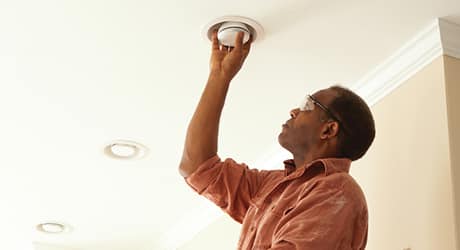Project Guide
How to Save Energy
Energy-efficient homes use less energy and as a result, produce lower energy bills. Simple changes such as installing a programmable thermostat, LED lights or insulating ducts can make a big impact.
This guide will show you six home energy-saving tips that will help you maximize your home energy efficiency while minimizing your home-operating costs.
Tools
- Duct Tape
- Slotted Screwdrivers
Materials
- Caulks & Sealants
- Door Seals
- Insulation
- LED Bulbs
- Storm Doors
1. Replace Incandescent Light Bulbs with LEDs

- LED bulbs use 75 percent less energy and last 35 to 50 times longer than incandescent bulbs. They are even more energy-efficient and last 10 times longer than CFLs.
- LEDs are more durable and less likely to break, while producing very little heat and remaining cool to the touch.
- These Earth-friendly bulbs are available as diffused high-power bulbs that can fit conventional pin or Edison screw sockets.
2. Upgrade to a Programmable Thermostat

Programmable thermostats can save you up to $180 per year on energy costs as pre-programmed settings will regulate your home temperature, reducing unnecessary wasted energy.
3. Seal and Insulate Your Home

An average of 25 percent of the heated or cooled air moving through your ducts is lost due to leaks and poorly sealed connections. Properly sealing ducts, caulking cracks or gaps, and insulating your attic can save you $550 per year in heating and cooling costs, or up to 10 percent of your annual energy bill.
4. Install Energy-Efficient Appliances

- Appliances account for up to 17 percent of your home’s energy use and using old appliances that drain energy equates to higher utility bills.
- You can recover the cost of new energy-saving appliances quickly by lowering your power bills. As an example, ENERGY STAR-qualified washing machines use just 50 percent of the energy of standard washers.
5. Weatherproof Your Windows

Windows can be the largest single source of energy loss in your home. If you can’t afford to upgrade to today’s energy-efficient models, weatherproofing your existing windows with weather stripping and caulk is the next best thing. Sealing drafts will help reduce winter-heating and summer-cooling costs.
6. Install a Storm Door

Storm doors save money by insulating and weatherproofing your entryway. They also improve your home’s curb appeal, increase security, and extend the life of your front door paint and fixtures.
